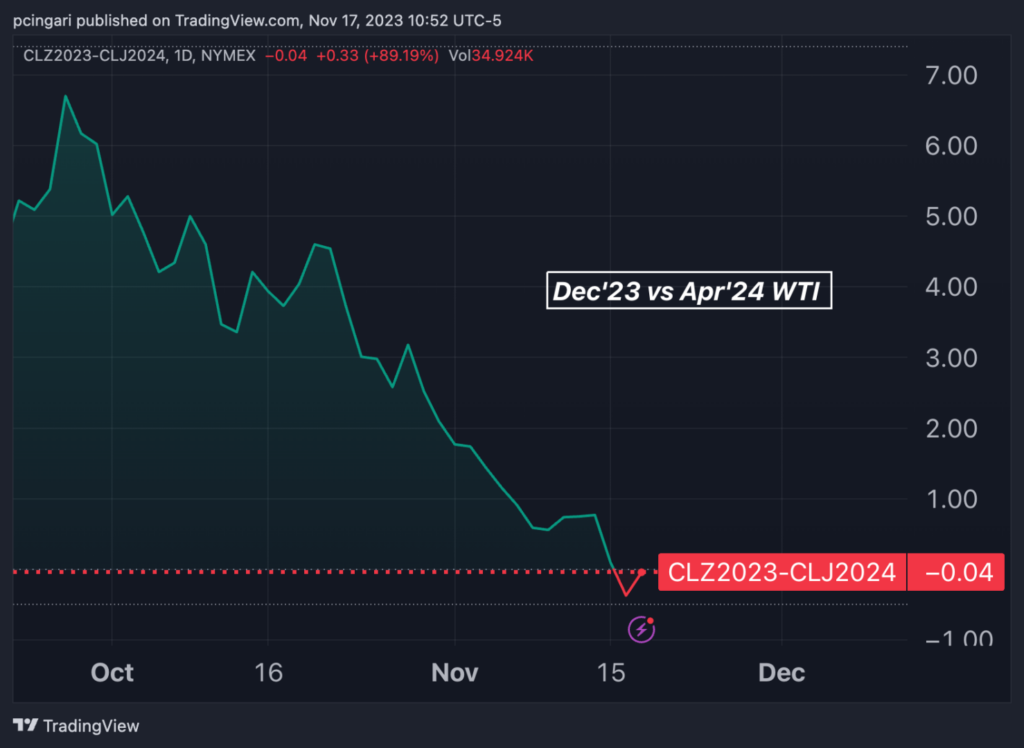Zinger Key Points
- Crude oil prices rose 2.7% on Friday, WTI reaching $75/barrel, rebounding from a nearly 5% drop.
- Oil market in contango, with the price for future contracts exceeding shorter-delivered ones, indicating supply outstripping demand.
- Don't face extreme market conditions unprepared. Get the professional edge with Benzinga Pro's exclusive alerts, news advantage, and volatility tools at 60% off today.
As OPEC gears up for a meeting in Vienna on Nov. 26, oil prices are on track for their fourth consecutive weekly loss.
Prices are hovering at levels last seen in mid-July as the market grapples with slowing demand and easing supply concerns.
Commodity analysts have identified a shift in the oil future curve toward contango. This situation, where futures prices surpass expected spot prices at maturity, indicates a willingness among traders to pay more for future-delivered oil.
Contango typically arises when current supply outstrips demand, leading to a decline in spot prices and expectations of a future price increase due to anticipated demand surges or supply constraints.
Currently, the curve displays a condition of contango up to five months, with the December contract (CLZ2023) trading at discount compared to the April 2024 contract (CLJ2024).
Chart: Oil Prices Enter ‘Contango’

Bear Market and Global Supply
Furthermore, the oil market has dipped into a bear market, with prices plunging 21% since September 2023’s highs.
West Texas Intermediate (WTI) surged to $75 a barrel on Friday, rebounding after Thursday’s 4.7% sell-off.
The United States Oil Fund USO, an exchange-traded security tracking the performance of the spot price of light sweet crude oil, is currently flat year to date.
Contributing factors include robust supplies, with increased shipments from Guyana and the North Sea, alongside surging U.S. exports. Last week, the U.S. Energy Information Administration (EIA) reported an increase in crude oil stocks by 3.592 million barrels. Overall, crude inventories are at their highest point in approximately two and a half months.
Upcoming OPEC Meeting
On Nov. 26, OPEC will discuss how to tackle the challenge of falling oil prices and fears about a potential weakening in global growth.
Goldman Sachs forecasts solid demand growth and reduced core OPEC supply in 2024, expecting the oil market to tighten moderately.
In the latest oil outlook, analysts, including Daan Struyven, outline three reasons why Brent prices are unlikely to fall sustainably below $80/bbl next year.
Firstly, OPEC’s intervention (“OPEC put”) will likely counteract any significant price dips. Secondly, a global economic “soft landing” is anticipated, where core inflation aligns with targets without significantly impacting labor or oil demand. Lastly, in the U.S., net public and private demand for oil tends to increase when prices drop.
“We believe that OPEC will ensure Brent in a $80-$100 range by leveraging its pricing power, with a $80 floor from the OPEC put, and a $100 ceiling from spare capacity,” Goldman Sachs wrote.
Read Also: Golden Opportunity: Portfolio Manager Highlights Unprecedented Discount In Gold Mining Stocks
Edge Rankings
Price Trend
© 2025 Benzinga.com. Benzinga does not provide investment advice. All rights reserved.
Trade confidently with insights and alerts from analyst ratings, free reports and breaking news that affects the stocks you care about.